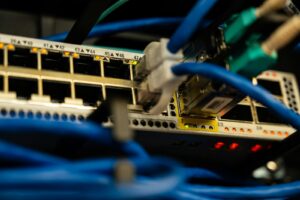Audio is one of those things where quality makes a massive difference. We’ve seen rapid advancements in technology over the last two and a bit decades, taking us from tapes and discs through to more digital means. Audio over Ethernet (AoE) is another advancement for businesses where audio plays a central role, giving you greater flexibility and control when compared to conventional systems – so here’s how AoE can help your business.
Understanding Audio over Ethernet
As you might expect, Audio over Ethernet involves transmitting digital audio signals over ethernet networks. This can mean using existing network infrastructure to transmit multiple channels of crystal-clear audio, rather than needing a system of analog cables of each individual channel.
By converting audio signals into data packets, it can fly through the network alongside other traffic via protocols configured for audio transmission – meaning nothing gets lost. The result? High fidelity audio at low latency without relying on audio compression.
Benefits of AoE for Businesses
There are a range of businesses that can benefit from AoE, from boardrooms using video calls through to event venues and stadiums. Given it can use existing network infrastructure, installation costs can be more reasonable than expected and make your audio capabilities much more robust.
Adding new speakers or adding audio into a new space is also simplified, as it mirrors connecting a new network device. Digital transmission can also eliminate interference or signal loss that can tamper with analog systems, which is a boon for recording high quality audio such as for audiobooks.
AoE systems can easily work with other IP-based systems like VoIP phones, security systems, and building automation. You can then also monitor the whole system from one location, similar to your IT network, which streamlines oversight.
Implementation and Hardware Requirements
As you might expect, setting up AoE systems requires a few key components – namely, ethernet cables. Your standard ethernet network will form the central nexus for AoE, so it’s well worth checking you have high quality connectors bringing things together. Category 5e or higher cabling is recommended, though the specific requirements depend on the chosen AoE protocol.
When thinking about compatible endpoints, you’ll need network-enabled speakers or amplifiers, audio encoders/decoders, and digital signal processors. Your business will dictate what you require, but make sure everything works with your network before diving into bigger purchases.
Practical Applications and Future Trends
You can already see AoE technology successfully implemented in many types of businesses – corporate environments with conference room audio, educational institutions for campus-wide PA systems, retail for zoned background music and promo announcements, and in healthcare for critical updates.
As more and more businesses look to digitize more of their operations, Audio over Ethernet presents a powerful solution for those seeking high-quality audio distribution over a secure network that can grow as their organization does. Plus, as smart technologies continue to become integrated into networks, the opportunities for AoE technology increase as well.

